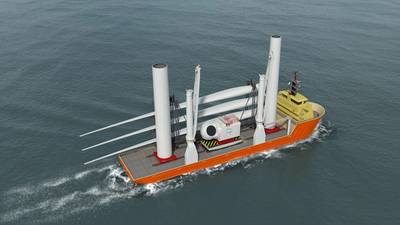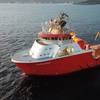Huisman Unveils Jones Act Offshore Wind Feeder Solution
The Netherlands-based crane and heavy machinery manufacturer Huisman has introduced a motion compensated platform engineered for the transfer of wind turbine components from a feeder vessel offshore.
The platform, which actively counterbalances the effects of vessel motions to provide a stable deck area, can be used aboard a feeder vessel for transporting components in U.S. waters since the use of internationally flagged wind turbine Installation vessels (WTIV) is restricted under the Jones Act.
Cees van Veluw, product manager at Huisman, said, “By using an offshore rated feeder vessel equipped with our Motion Compensated Platform, the jack-up vessel can continue installation work without having to shuttle back and forth to load new components. Maximizing the operational time results in a faster and more reliable delivery of an offshore wind farm, compared to more traditional feeder solutions.”
Huisman noted the dimensions and capacities of the motion compensated platform are optimized for next-generation wind turbines and are designed to compensate for five degrees of vessel motions. The platform can be integrated into the hold of a vessel and aligned with the main deck, making it easy to skid cargo across the platform.
 (Image: Huisman)
(Image: Huisman)
Huisman said it aims to grow its presence in the U.S. offshore wind market. It has facilities in the Houston area to locally support the North American market.
In December 2020, the company was contracted by Brownsville, Texas shipyard Keppel AmFELS for the delivery of a 2,200mt leg encircling crane for the first Jones Act compliant WTIV, Charybdis, ordered by Dominion Energy.
In May 2020, the first monopile foundations in U.S. federal waters were installed by Jan de Nul’s vessel Vole au Vent, using Huisman’s motion compensated monopile gripper.












